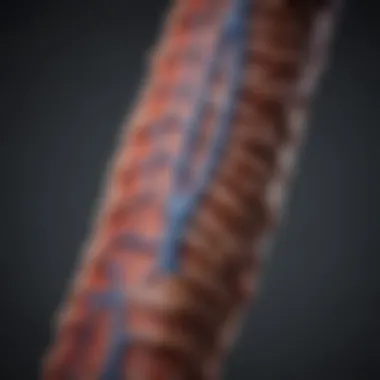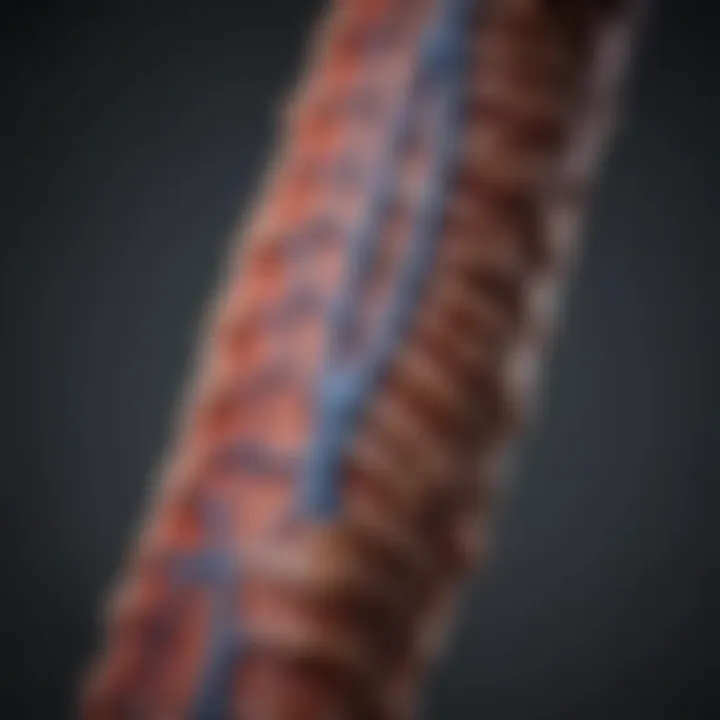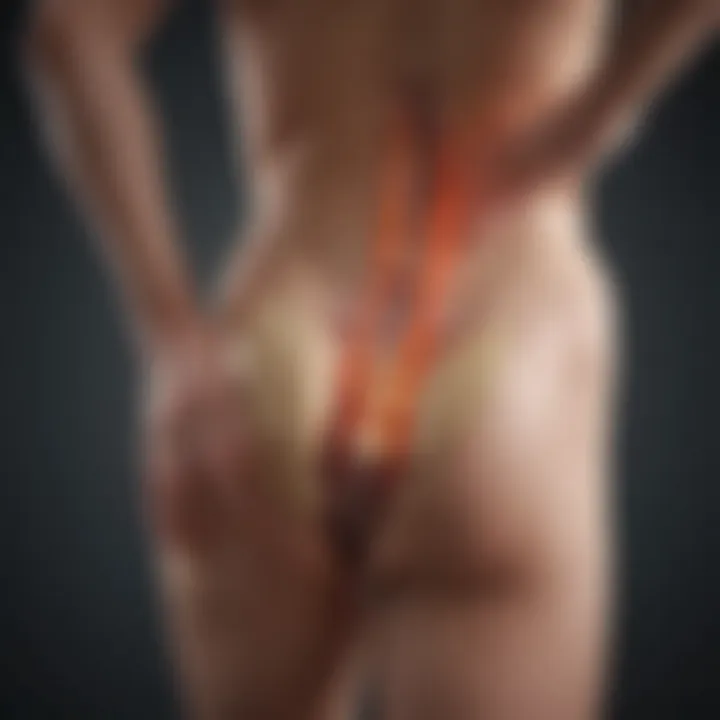Understanding Backbone Arthritis: An In-Depth Exploration


Intro
Backbone arthritis, or spinal osteoarthritis, is a significant condition that compromises the integrity of the spine. This type of arthritis affects millions of individuals worldwide and can lead to debilitating pain and decreased mobility. Understanding this complex ailment is essential for both medical professionals and patients alike. The need for comprehensive research in this area is underscored by its impact on quality of life.
Background and Context
Overview of the Research Topic
Backbone arthritis arises as a degenerative joint disease primarily affecting the facet joints of the spine. These joints play a crucial role in allowing movement and flexibility. Over time, wear and tear on these joints causes inflammation, pain, and stiffness. Knowing the underlying mechanisms can aid in developing effective treatments and improving patient outcomes.
Historical Significance
Historically, the understanding of backbone arthritis has evolved. Initially, the condition was often dismissed as a natural part of aging. However, advances in medical imaging and research have broadened perspectives. Today, researchers recognize the multifactorial nature of backbone arthritis, often linking it to genetics, lifestyle, and injury. This shift in understanding has led to improved diagnostic techniques and treatment strategies.
Key Findings and Discussion
Major Results of the Study
Recent studies highlight various aspects of backbone arthritis. Research indicates that this condition tends to worsen with age, although it is not exclusive to older adults. Factors such as obesity and sedentary lifestyle significantly contribute to the progression of osteoarthritis in the spine. Additionally, studies show that certain genetic markers may predispose individuals to developing this condition.
Detailed Analysis of Findings
A critical area of research focuses on how backbone arthritis affects daily life. Findings suggest that individuals with this condition often report chronic pain and a limitation in mobility. As a result, physical and psychological well-being may decline. Furthermore, recent comparative studies suggest that active management, including physical therapy and lifestyle changes, may mitigate symptoms and enhance the quality of life for affected individuals.
"Understanding the complexity of backbone arthritis is crucial for improving treatment and patient care."
Research also emphasizes the necessity of early diagnosis. Magnetic resonance imaging (MRI) and X-rays play significant roles in diagnosing backbone arthritis. Understanding how to interpret these images is vital for practitioners aiming to provide optimal care. Overall, ongoing research continues to aim for deeper insight into effective treatment approaches.
Preamble to Backbone Arthritis
Backbone arthritis, also known as spinal osteoarthritis, significantly affects many individuals, casting a shadow over their daily lives. An understanding of this condition is crucial for both the general public and healthcare professionals. It sheds light on the complexities involved in spinal health and the factors contributing to the problem of arthritis in the back.
The importance of addressing backbone arthritis hinges on several key elements. First, spinal osteoarthritis is a progressive disease. Understanding its progression can lead to earlier detection and potentially better management of symptoms. Patients often describe chronic pain, stiffness, and limitations in mobility that create barriers in their professional and personal lives. The physical struggle is paired with emotional challenges, as this condition can impact mental health as well.
Additionally, spine health is intertwined with overall health. Knowledge about backbone arthritis allows for informed discussions about treatment options, lifestyle adjustments, and preventative measures. This not only benefits the affected individuals but also enhances the understanding of caregivers and healthcare providers regarding the best strategies for management.
Thus, as we delve into the mechanisms, symptoms, and various aspects of backbone arthritis in this article, we aim to provide essential insights. These insights can help develop ways to improve the quality of life for those affected by it.
Overview of Osteoarthritis
Osteoarthritis is a degenerative joint disease characterized by the breakdown of cartilage, which cushions the ends of bones. It is the most common form of arthritis, affecting millions worldwide. In the context of the spine, it involves the degeneration of cartilage between the vertebrae, leading to pain, swelling, and difficulty moving.
Key points about osteoarthritis include:
- Degeneration: As cartilage deteriorates, bones may rub against each other, causing pain and additional joint damage.
- Symptoms: Common symptoms are joint pain, stiffness, and restricted movement, which can worsen after periods of inactivity.
- Risk Factors: Age, previous joint injuries, obesity, and genetic predispositions contribute to the likelihood of developing osteoarthritis.
Osteoarthritis in the spine can lead to more serious complications, such as nerve compression, which may necessitate further medical intervention.
Definition of Backbone Arthritis
Backbone arthritis, specifically referring to spinal osteoarthritis, is a term that describes the wear and tear of the spinal joints due to the aging process and other risk factors. It primarily affects the lumbar and cervical regions of the spine and can create significant discomfort.
In simpler terms, backbone arthritis is marked by:
- Joint Cartilage Breakdown: The smooth cartilage becomes rough, leading to pain and swelling in the affected area.
- Formation of Bone Spurs: As the body attempts to repair itself, it may develop bone spurs in the affected joints, which can exacerbate pain and restrict mobility.
- Impact on Nerve Roots: The condition can cause compression on nearby nerves, leading to symptoms such as tingling or numbness in the extremities.
Understanding backbone arthritis lays the groundwork for appreciating its symptoms and the potential treatments available.
Anatomy of the Spine
The anatomy of the spine is crucial for understanding backbone arthritis. The structure and function of the spinal column are integral to maintaining overall mobility and stability. This section focuses on the specific components that contribute to spinal health and the implications of their deterioration.
Structure of the Vertebrae
The vertebrae are the individual bones that stack to form the spinal column. These bones are classified into regions: cervical, thoracic, lumbar, sacral, and coccygeal. Each region serves unique functions, with the cervical vertebrae supporting the head, while lumbar vertebrae bear much of the body’s weight.
Each vertebra consists of several parts: the vertebral body, arch, and the processes. The vertebral body is strong and bulky, providing support, while the arch forms the vertebral foramen, creating a protective canal for the spinal cord. Additionally, the spinous processes and transverse processes serve as attachment points for muscles and ligaments. This intricate structure allows for both stability and mobility, but age-related changes can lead to degeneration, which is often seen in backbone arthritis.
Spinal Discs and Nerve Roots
Spinal discs are the cushioning structures situated between each vertebra. They consist of an outer layer known as the annulus fibrosus and a gel-like core named the nucleus pulposus. Their primary role is to absorb shock and allow for flexibility within the spine. As people age, these discs can lose hydration and elasticity, leading to reduced disc height and contributing to conditions like backbone arthritis.
In addition to the discs, nerve roots emerge from the spinal column to innervate various body parts. These nerves are essential for carrying signals between the brain and the body. When arthritis affects the spine, inflammation can impact these nerve roots, leading to pain and neurological symptoms. Understanding the anatomy of both the vertebrae and the spinal discs helps in comprehending the physiological changes that occur in backbone arthritis, emphasizing the need for early diagnosis and intervention.
Backbone arthritis often leads to nerve compression, resulting in pain and reduced mobility.


In essence, the anatomy of the spine reveals the complexity and interdependence of its parts. A clear grasp of this complexity aids both health professionals and patients in understanding the condition and its potential impacts on daily functioning.
Pathophysiology of Backbone Arthritis
The pathophysiology of backbone arthritis is a critical aspect of understanding this condition. It involves studying the biological mechanisms that contribute to the onset and progression of spinal osteoarthritis. By grasping these mechanisms, healthcare professionals and researchers can develop more effective treatments and interventions.
Mechanisms of Cartilage Degeneration
Cartilage degeneration is central to the pathophysiology of backbone arthritis. The cartilage acts as a cushion between the vertebrae, absorbing shock and allowing for smooth movement. In backbone arthritis, this cartilage begins to break down due to various factors.
Key elements of cartilage degeneration include:
- Biomechanical Stress: Over time, repeated stress on the spine from heavy lifting or awkward postures can lead to cartilage wear.
- Cellular Changes: Chondrocytes, the cells within cartilage, become less effective at maintaining cartilage health as they age. This inefficiency contributes to degeneration.
- Molecular Factors: Increased levels of inflammatory cytokines can disrupt the homeostasis of cartilage. These molecular components are critical in the degeneration process.
This degeneration leads to pain, stiffness, and reduced mobility. It is essential for patients and practitioners to recognize these mechanisms for managing symptoms effectively.
Inflammatory Processes in the Spine
Inflammatory processes play a significant role in backbone arthritis. They do not just harm the cartilage but also affect other structures in the spine. Inflammation can result from mechanical stress, previous injuries, or systemic diseases.
Consider these points regarding inflammation in the spine:
- Cytokine Release: When the spinal tissue is damaged, pro-inflammatory cytokines are released. This release amplifies pain signals and leads to further tissue damage.
- Synovial Inflammation: The synovial membrane lining the spine may also become inflamed, contributing to joint stiffness and pain.
- Neurogenic Inflammation: Changes in nerve tissue can lead to heightened pain responses, complicating the symptoms of backbone arthritis significantly.
Understanding inflammation is crucial for developing targeted therapies aimed at alleviating pain and slowing disease progression.
In summary, the pathophysiology of backbone arthritis encompasses complex mechanisms involving both cartilage degeneration and inflammatory processes. Recognizing these elements provides vital insight into effective treatment strategies, enhancing the quality of life for affected individuals.
Etiology of Backbone Arthritis
The etiology of backbone arthritis is a crucial aspect to understand when examining this condition. This section provides insight into the various factors contributing to its development. Recognizing the causes, types, and relevant influences can help in formulating prevention strategies and effective treatment plans. By understanding these elements, individuals can better navigate their health decisions and assess their risk.
Genetic Predispositions
Genetic factors can have a significant influence on the likelihood of developing backbone arthritis. Studies indicate that certain genetic markers can be associated with increased risk for osteoarthritis. For example, individuals with a family history of spine-related disorders may be more prone to developing this condition. The presence of specific genotypes can also influence cartilage health and maintenance.
To assess genetic predispositions, researchers often conduct family studies. These studies help in identifying patterns of inheritance and the presence of mutations that could predispose one to degenerative spine conditions. Advances in genetic research may uncover more links between genes and backbone arthritis. In understanding these genetic aspects, patients can better comprehend their condition and possible preventive measures.
Environmental Factors and Lifestyle Choices
The role of environmental factors and lifestyle choices in the onset of backbone arthritis cannot be underestimated. Different lifestyle habits and daily activities can put stress on the spine. Heavy lifting, repetitive motions, and long periods of poor posture can contribute significantly to spine degeneration. Workers in manual labor occupations or those who spend most of their day sitting may experience an increased risk of developing arthritis in the backbone.
Moreover, nutrition also plays a role in the health of the joints and spine. A diet rich in antioxidants and anti-inflammatory foods, like fruits and vegetables, may help in reducing inflammation in the body. Conversely, diets high in processed foods and sugars can exacerbate inflammatory responses. Acknowledging the need for dietary changes is essential in managing and preventing backbone arthritis.
Factors such as obesity can further complicate matters, as excess weight adds stress on the spine and can accelerate cartilage breakdown. Therefore, lifestyle modifications are necessary to mitigate the risk factors associated with this condition.
Age and Gender Considerations
Age is a significant factor in the etiology of backbone arthritis. As individuals age, the risk of developing osteoarthritis increases. This is largely due to the natural wear and tear on the joints and spine over time. The cartilage that cushions the vertebrae often diminishes with age, leading to pain and stiffness.
Gender also plays a role in the development of backbone arthritis. Research suggests that women, particularly post-menopausal, may be at a higher risk for developing osteoarthritis. This could be attributed to hormonal changes that affect bone density and joint health. Furthermore, men tend to develop arthritis at a younger age compared to women, making it critical to consider both gender differences and age-related risks.
In summary, recognizing the etiology of backbone arthritis involves understanding genetic predispositions, environmental factors, lifestyle choices, as well as age and gender considerations. These elements form a complex overview of how backbone arthritis develops, leading to more informed decisions and potential treatments for those affected by this condition.
Symptoms and Signs
Understanding the symptoms and signs of backbone arthritis is fundamental in recognizing and addressing this condition. The early identification of symptoms can facilitate timely interventions and improve patient outcomes. Effective management largely hinges on awareness of how backbone arthritis manifests.
Chronic Pain Characteristics
Chronic pain is a defining feature of backbone arthritis. This pain typically presents as a persistent ache in the lower back or neck, often becoming worse with activity. Patients may describe this pain as dull or sharp, and it may radiate to other areas, such as the legs or arms.
Key characteristics of chronic pain include:
- Intensity: Pain levels can fluctuate, ranging from mild discomfort to severe pain limiting daily activities.
- Duration: Unlike acute pain that resolves quickly, chronic pain endures for months or years, affecting long-term quality of life.
- Triggering Factors: Movement, bending, or prolonged sitting can exacerbate the pain, leading to a cycle of avoidance and increased disability.
- Response to Treatment: While some patients may find relief through medication or physical therapy, others may experience persistent pain even with treatment.
Recognizing these pain patterns is crucial for guiding effective management strategies.
Stiffness and Mobility Limitations
Stiffness and limitations in mobility are also prominent symptoms of backbone arthritis. These symptoms often present upon waking or after prolonged periods of inactivity, reflecting limitations in the spine's flexibility.
The implications of stiffness include:
- Morning Stiffness: Many individuals experience heightened stiffness in the mornings, necessitating longer periods of stretching or movement to alleviate it.
- Reduced Range of Motion: Activities that require bending, twisting, or lifting may become increasingly difficult. Many individuals report a sensation of tightness that restricts their movements.
- Impact on Daily Activities: Simple tasks like dressing or reaching may be hindered, leading to frustration and a sense of dependency on others.
- Progressive Nature: Over time, stiffness can become more pronounced, further limiting physical capabilities and contributing to muscular weakening surrounding the spine.
Both chronic pain and stiffness significantly contribute to a decreased quality of life. Recognizing these symptoms early can lead to more proactive management and ultimately improved functional outcomes for individuals affected by backbone arthritis.


"Acknowledging chronic pain and stiffness as essential symptoms promotes better understanding and care for those with backbone arthritis."
Through comprehensive assessment of these symptoms, healthcare professionals can devise targeted treatment plans that address not only physical limitations but also the psychological aspects of living with chronic pain.
Diagnosis of Backbone Arthritis
Diagnosing backbone arthritis is essential for optimal management of the condition. Early detection can lead to timely interventions, which may slow disease progression and improve quality of life. Proper diagnosis involves a multifaceted approach that integrates clinical evaluations, imaging studies, and laboratory tests. Understanding each component is crucial for an accurate diagnosis.
Clinical Evaluations
Clinical evaluations form the backbone of the diagnostic process for backbone arthritis. During these assessments, healthcare professionals will conduct a thorough medical history review and a physical examination.
- Medical History: Patients' descriptions of their symptoms, including the duration and intensity of pain, can provide significant clues. Understanding any potential family history of arthritis or other musculoskeletal disorders is also important.
- Physical Examination: This evaluation usually includes checking for tenderness, swelling, and range of motion. The physician may ask the patient to perform specific movements. Evaluating pain levels during these activities can help gauge how the arthritis affects daily life.
These evaluations help create a clinical picture that guides further diagnostic steps. Any inconsistencies or abnormalities observed can warrant additional diagnostic tests.
Imaging Studies
Imaging studies play a crucial role in the diagnosis of backbone arthritis. They provide visual insights into the condition of the spine and surrounding structures, crucial for confirming or ruling out arthritis.
- X-rays: They are often the first-line imaging study. X-rays can reveal changes in bone structure, cartilage degeneration, and the presence of bone spurs, which are indicative of arthritis.
- Magnetic Resonance Imaging (MRI): An MRI offers detailed images of soft tissues, including cartilage and discs. This imaging is especially valuable in detecting early degenerative changes that may not be visible on X-rays.
- Computed Tomography (CT) Scans: CT scans may be utilized to obtain cross-sectional images of the spine. They can be particularly useful when advanced detail about spine anatomy is necessary.
These imaging modalities are integral in tailoring an effective treatment plan.
Laboratory Tests and Biomarkers
Laboratory tests and biomarkers can complement clinical evaluations and imaging studies in diagnosing backbone arthritis. While there are no definitive blood tests for osteoarthritis, several tests can aid in the diagnostic process.
- Inflammation Markers: Tests such as C-reactive protein (CRP) or erythrocyte sedimentation rate (ESR) can indicate the presence of inflammation, which may suggest arthritis.
- Rheumatoid Factor: This test can be helpful in excluding rheumatoid arthritis, as it may present similarly.
- Synovial Fluid Analysis: In certain cases, a healthcare professional may analyze joint fluid if arthritis is suspected. A sample can help rule out gout or infections that present with similar symptoms.
By utilizing a combination of clinical evaluations, imaging studies, and laboratory tests, healthcare providers can establish a comprehensive understanding of backbone arthritis. This thorough approach ensures that patients receive accurate diagnoses and appropriate care.
Treatment Approaches
Understanding the various treatment approaches for backbone arthritis is crucial for effective management of this condition. These strategies aim not only to alleviate symptoms but also to improve overall spinal health and enhance the quality of life for individuals affected by this chronic ailment. A comprehensive approach encompasses pharmacological interventions, physical therapy, and, where necessary, surgical options. Each of these treatments has specific elements and considerations that should be weighed carefully to determine the best course of action for each patient.
Pharmacological Interventions
Pharmacological interventions are often the first line of treatment for backbone arthritis. This category includes non-steroidal anti-inflammatory drugs (NSAIDs) such as ibuprofen and naproxen, which help reduce inflammation and relieve pain. In some cases, stronger medications like corticosteroids may be prescribed to manage severe symptoms. Muscle relaxants can also play a role in alleviating muscle tension associated with spinal arthritis.
The objective of pharmacological treatment is to minimize pain and inflammation while enabling individuals to engage in activities of daily living.
However, clinicians must consider the potential side effects and long-term implications of these medications. Regular monitoring and adjustments may be necessary to balance efficacy with safety. Notably, some patients may also benefit from topical treatments or supplements such as glucosamine and chondroitin, although evidence regarding their effectiveness is mixed.
While pharmacological interventions provide immediate relief, they are typically most effective when combined with other treatment modalities.
Physical Therapy and Rehabilitation
Physical therapy is an essential component of treatment for backbone arthritis. This approach focuses on enhancing mobility, increasing strength, and promoting overall spinal stability. A trained physical therapist can design a personalized program tailored to the individual's specific needs and limitations.
Key elements of physical therapy include:
- Strengthening exercises: Target core muscles that support the spine.
- Flexibility training: Stretching exercises to improve range of motion.
- Manual therapy: Techniques such as manipulation and mobilization to ease pain and stiffness.
- Education on posture and body mechanics: Patients learn how to protect their spine during daily activities.
Engaging in a regular exercise regimen not only aids in immediate pain relief but also contributes to long-term benefits such as reduced risk of further injury and improved function. Rehabilitation programs may also integrate modalities like heat and ice therapy, electrical stimulation, or ultrasound therapy as adjunct treatments.
Surgical Options
In cases where non-surgical methods are inadequate, surgical interventions may be considered. Surgical options for backbone arthritis can range from minimally invasive procedures to more extensive operations. The choice of surgery depends on factors such as the severity of symptoms, the extent of spinal deterioration, and the patient's overall health.
Common surgical procedures include:
- Laminectomy: Removal of part of the vertebra to relieve pressure on the spinal cord or nerves.
- Spinal fusion: Joining two or more vertebrae to stabilize the spine and alleviate pain.
- Disc replacement: Replacing damaged discs to restore normal disc function and relieve pain.
Surgical options can provide significant pain relief and improved function; however, they also come with risks and potential complications. Thus, thorough discussion with a healthcare provider is essential to align expectations and consider the implications of surgery on overall health and lifestyle.
Lifestyle Modifications
Lifestyle modifications play a crucial role in managing backbone arthritis. These adjustments can significantly improve the patient’s quality of life. In particular, dietary changes and increased physical activity have shown substantial benefits. By making informed decisions about daily habits, individuals can alleviate pain, enhance mobility, and reduce the progression of the disease.
Overall, it is essential to create a balance between physical health and emotional well-being when dealing with chronic pain conditions.
Diet and Nutrition Considerations
The diet can greatly affect inflammation and pain levels. Patients are encouraged to consume anti-inflammatory foods. These foods are generally rich in omega-3 fatty acids, antioxidants, and vitamins. Examples include:


- Fatty fish (like salmon and mackerel)
- Nuts (such as walnuts and almonds)
- Fruits (like blueberries and strawberries)
- Vegetables (notably dark leafy greens)
In addition, avoiding processed foods, sugar, and excessive red meat is advised. These can exacerbate inflammation. Hydration is also essential. Drinking adequate water supports overall joint health, helping to maintain the elasticity of cartilage.
Exercise Regimens and Their Benefits
Regular exercise is another powerful tool for managing backbone arthritis. It helps to strengthen the muscles surrounding the spine, which can alleviate pressure on vertebrae and discs. Various forms of exercise provide unique benefits:
- Low-impact aerobic activities: Walking, swimming, and cycling are excellent options. They improve cardiovascular health without putting undue stress on the joints.
- Strength training: Using light weights or resistance bands can help build muscle support. This stabilizes the spine and enhances overall functionality.
- Flexibility exercises: Stretching or yoga may help improve range of motion. These practices can also provide pain relief by reducing stiffness.
Regular physical activity is essential for people suffering from backbone arthritis. It not only helps maintain a healthy weight, but also promotes overall physical and mental health.
Impact on Quality of Life
Understanding the impact of backbone arthritis on quality of life is crucial. This condition not only affects physical health but also influences emotional and social dimensions of a person's life. Many people living with backbone arthritis experience persistent pain, which can severely limit their daily activities. Such limitations complicate simple tasks like lifting objects, bending, or maintaining positions for extended periods. As these physical constraints pile up, they can result in a decreased ability to participate in enjoyable activities, leading to a feeling of isolation and depression.
Moreover, the nature of chronic pain often leads to a struggle with sleep patterns. Inadequate rest can subsequently contribute to fatigue, further hindering mobility and concentration. This cycle of discomfort and distress underscores a pressing need for a comprehensive approach to managing backbone arthritis, addressing not only the physical symptoms but also the emotional aspects that stem from chronic pain.
"Backbone arthritis significantly impacts both physical and emotional well-being, creating a complexity that requires thorough understanding and management."
When affected individuals can understand, modify, and adapt to their limitations, they can improve their daily functioning. Recognizing this intersecting impact illuminates the necessity for customized treatment plans, social support, and educational resources aimed at restoring both physical mobility and psychological resilience, ultimately contributing to a better quality of life.
Physical Limitations and Daily Activities
People with backbone arthritis often face substantial physical limitations. These constraints can vary widely among individuals, which makes understanding their implications on daily activities essential. Common restrictions include decreased range of motion and increased stiffness, which may diminish an individual's ability to engage in routine tasks.
Some physical limitations can include:
- Difficulty in Walking: Pain can make it hard to walk long distances.
- Bending and Lifting: Tasks that require bending over or lifting items may become painful or impossible.
- Repetitive Movements: Activities that require repetitive motions can exacerbate discomfort.
As these restrictions escalate, they often translate into changes in work capabilities and hobbies. Many individuals may need to adjust their roles at work, seek assistance in their home chores, or even abandon hobbies they once enjoyed.
Over time, these changes can lead to a feeling of helplessness. It is imperative to introduce adaptive strategies and tools designed to minimize the impact of these physical limitations. For instance, ergonomic tools can aid in daily tasks, while assistive devices like walkers and braces may foster greater independence.
Psychosocial Effects of Chronic Pain
Chronic pain resulting from backbone arthritis breeds significant psychosocial challenges. Many affected individuals report feelings of anxiety, stress, and depression. The intrusive nature of persistent pain can lead to social withdrawal and impact relationships.
It is important to recognize how the psychological effects are intertwined with physical health. Common psychosocial effects include:
- Social Isolation: Individuals may withdraw from social interactions due to fear of pain or embarrassment.
- Emotional Distress: Persistent discomfort can lead to heightened levels of frustration and hopelessness.
- Reduced Self-Esteem: The inability to perform activities once taken for granted may diminish self-worth.
Integrating mental health support within treatment plans offers a pathway to address these emotional barriers. Therapies, such as cognitive-behavioral therapy, can empower individuals to reframe their experiences and develop coping strategies. A multi-faceted approach that prioritizes both physical and mental health is vital to elevating the overall quality of life for those living with backbone arthritis.
Emerging Research and Future Directions
Emerging research in backbone arthritis presents a crucial sphere of study that could potentially reshape our understanding and management of the condition. With advancements in technology and a deeper comprehension of pathophysiological mechanisms, researchers are discovering innovative strategies aimed at improving the quality of life for affected individuals. This section explores key themes in contemporary research, focusing on treatment modalities and understanding disease progression.
Innovative Treatment Modalities
Research is continually uncovering innovative treatment modalities that could revolutionize how backbone arthritis is managed. One significant area of exploration is the development of biologic therapies which target specific pathways involved in inflammation and cartilage degradation. These therapies aim to not only relieve symptoms but also modify the underlying disease process.
Recent developments in stem cell therapy are also noteworthy. Some studies show that stem cell injections could promote regeneration of damaged spinal tissues. While the results are still preliminary, the potential for enhanced recovery offers promising avenues for patients with severe joint degeneration.
Additionally, advancements in gene therapy could pave the way for new interventions. By targeting genetic mutations associated with osteoarthritis, researchers aim to create personalized medicines that address the root causes rather than solely managing symptoms. These treatments are still in early experimental stages, but they highlight the transformative potential that emerging research holds.
"The future of arthritis treatment lies in understanding the molecular and genetic underpinnings of disease. Each patient may respond differently, requiring personalized approaches."
Understanding Disease Progression
Another vital area of future research is the understanding of disease progression in backbone arthritis. Studying how the disease evolves is instrumental in developing early intervention strategies. Current research is focused on identifying biomarkers that can predict disease onset and severity. Such insights could enable healthcare providers to initiate preemptive care to slow progression before debilitating symptoms occur.
One approach involves using imaging techniques, such as magnetic resonance imaging (MRI), to observe changes in spine structure over time. This technique helps researchers track how joint space narrows or whether osteophyte formation is taking place, giving clues about the rate of degeneration.
Longitudinal studies are being initiated to monitor patients over extended periods. By examining genetic, lifestyle, and environmental factors, these studies hope to create a comprehensive picture of how backbone arthritis develops across different populations.
Closure
The conclusion of this article serves as a pivotal moment in synthesizing the extensive exploration of backbone arthritis. It is essential to highlight the multifaceted nature of this condition, which affects countless individuals around the world. As our investigation into the topic draws to a close, the importance of the insights gained become clear.
Summary of Key Insights
In summary, backbone arthritis, also referred to as spinal osteoarthritis, has profound implications on spinal health and overall quality of life. Key insights gained from this article include:
- The structure and function of the spine play a critical role in understanding how arthritis develops.
- Symptoms such as chronic pain and limited mobility significantly affect daily life.
- Diagnosis typically involves a combination of clinical evaluations, imaging studies, and laboratory tests to confirm the presence of arthritis.
- Treatment options, while diverse, must often be tailored to the individual's specific needs and conditions.
- Lifestyle modifications, including diet and exercise, can greatly enhance the management of symptoms.
- Ongoing research into innovative treatments and a deeper understanding of disease progression is vital for future progress.
By synthesizing these points, we reinforce the importance of awareness and education around backbone arthritis.
Call for Continued Research and Awareness
Continued research and public awareness about backbone arthritis are crucial. Several reasons underscore this need:
- Rising Prevalence: As the population ages, the incidence of arthritis is expected to increase. Growing awareness can lead to earlier diagnosis and intervention.
- Innovative Treatments: Research into new treatment methodologies can provide relief to those suffering from this condition.
- Patient Education: Informing patients and care providers about symptoms and management options is vital for improving quality of life.
- Holistic Approaches: Emphasizing lifestyle changes can lead to better outcomes for individuals living with arthritis.







